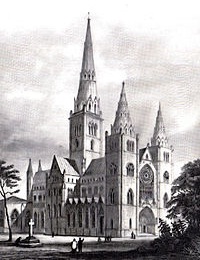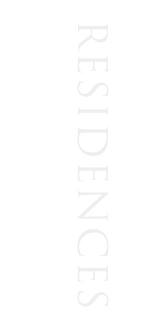|
 Like
all similar fabrics of its time, the Cathedral of Elgin stood
due east and west, and was built in the form of a Jerusalem or
Passion cross. The choir and altar faced the east, or head of
the cross, with the branches, transepts, or cross wings, to the
north and south, and the grand entrance through the western
extremity, or foot of the cross. The grand tower rose from its
centre. The west gate, flanked with two massive but elegant
towers, and the chapterhouse, appended to the northern
cloisters, with parts of the transepts, are all tolerably
perfect; the whole displaying workmanship of the most intricate
and exquisite beauty. Like
all similar fabrics of its time, the Cathedral of Elgin stood
due east and west, and was built in the form of a Jerusalem or
Passion cross. The choir and altar faced the east, or head of
the cross, with the branches, transepts, or cross wings, to the
north and south, and the grand entrance through the western
extremity, or foot of the cross. The grand tower rose from its
centre. The west gate, flanked with two massive but elegant
towers, and the chapterhouse, appended to the northern
cloisters, with parts of the transepts, are all tolerably
perfect; the whole displaying workmanship of the most intricate
and exquisite beauty.
Surrounding the
cathedral was a substantial wall. 8 feet in height, and entered
by five gates. It enclosed an area 900 yards in circumference,
called The College, and included the manses and gardens of the
Dean, the Prebendaries, and the other dignified members of the
chapter, and a paved street ran around the whole area. The only
gate to the precincts now remaining is the eastern, named the
Water-gate, or Pann'i port, which was formerly defended by an
iron portcullis. The College was the residence of the Dean, who
was Rector of Auldearn. The manse of the sub-dean still exists,
but has been much enlarged and altered. The Episcopal Palace is
on the south of the Cathedral.
In 1589, the
Abbey of Dunfermline, with its lands and privileges, was erected
into a temporal lordship, which was conferred upon Anne of
Denmark, Queen of James VI. In 1593, Queen Anne appointed
Alexander Seton, son of George, 7th Lord Seton, Heritable
Baillie of her Lordship of Dunfermline. The house of the
Bishop of Moray, in the town of Elgin, was granted to Alexander Seton, along with
the Priory lands of Pluscarden and the Lordship of Urquhart.
The Elgin mansion received the name of "Dunfermline House" from
the circumstance of the priories of Urquhart and Pluscarden
being dependent upon the great Fifeshire Abbey. From a letter
written by Lord Dunfermline to John Innes of Leuchars, in 1618,
he seems to have then been engaged in embellishing the gardens
of his Elgin abode. "I think," he says, "all ye have done to my
yeardes wereye weill and ordourlie, and am content ye superseid
the outredding of the warke, till your leisour and commoditie
may permitt you to see it donne. Insteid of thankis and
recompence, I am even to burdein you the forder, and to requeist
you sa sone as you may in the nixt sasone, after the ground
shall be redde and cleare, to cause outredde and cleare the
same; for truilie I think lang to be in that countrie."
The Precentor's manse was
granted to Alexander Seton simultaneously with his appointment
as lay commendator of Pluscarden Priory, and he renamed the
manse to Dunfermline House during the period when he was
Provost of Elgin (1591–1607, and after was also Provost of Edinburgh, 1598–1608).
In 1604 he was appointed by King James VI, Chancellor of
Scotland, and
the following year was raised to the peerage with the title of
1st Earl of Dunfermline.
In
the year 1595, he had sold the barony of Pluscarden and certain
other lands to Kenneth Mackenzie of Kintail, but retained the
Lordship of Urquhart and the mansion-house in Elgin, where he
appears to have frequently resided. In the Charter of Sale,
which is now at Duff House, he describes himself "Alexander
preses Collegii Justicie," and signs "A. Seton, Urquhart," along
with his first wife "Lilias Drumond."
The house being
frequented by cadets of the Seton house, from the registered Testament of the " umq. Captain
Patrick Seytoun, brother german to umq. John Seytoun of Lathrisk,"
that he died " in Elgin, in Murray, in the hous of the richt
nobill and potent Lord Alex'- Lord of Fyvie, President," on the
16th of February 1600. The Will is dated two days previously,
and witnessed, among others, by Lord Fyvie. The testator leaves
various legacies to nephews and other relatives, — among the
rest, 900 merks and his "monturs" [saddle-horses] to be as
heirship to John Seytoun, his nephew and heir of line; and to
Janet Duddingstoun, Lady Lathallan, 200 merks, "together with
his braceletts of gold, silver saltsatt [salt-cellar], and two
spoons, with a coupe."
A
detailed account of Dunfermline House will be found in
Chalmers's History of Dunfermline, vol. ii pp. 404 and 432. A
shield of arms, surmounted by a coronet and accompanied by the
date " 1688 " and the initials " I. E. D." and "I. C. D.," was
formerly over a door in the north court of the building — the
initials being those of the Chancellor's grandson, James, 4th
and last Earl of Dunfermline, and his Countess, Jean Gordon,
sister of George, 1st Duke of Gordon.
Following
the forfeiture and death in France of the 4th Earl of Dunfermline, it's
title and ownership passed to the Seton's of Barnes. Sir George
Seton of Barnes and Hailes held claim to it, selling his share
and right to the Duke
of Gordon, who although preserving it for time, the house is now in ruins.
Captain A. H. Dunbar
kept a sketch of an old stone at
Elgin, bearing three curiously shaped escutcheons charged with
the arms of Seton, Dunbar, and Falconer. The first, exhibits
Seton and Buchan quarterly, between the letters "A. S." (the
initials of the Chancellor), and surmounted by the words -"
lESVS RENVE A RIGHT SPIRIT WITHIN GOD."
|

